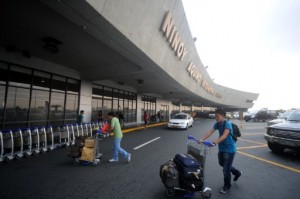The Management Association of the Philippines (MAP) has called for the redevelopment of both Ninoy Aquino International Airport (NAIA) and the Clark International Airport (CIA) as part of a “holistic” solution to Greater Manila Area’s clamor for a more modern, spacious and efficient aviation system.
“The rapid increase in the volume of visitors to the Philippines, most of whom pass through the NAIA, calls for immediate action and the harnessing of all available resources to promptly provide the needed infrastructure and management support for the growing number of air passengers,” MAP said in a position paper.
Airport infrastructure is a hot item for many business groups, which are scrambling to participate in aviation-related projects to be sanctioned by the government.
The group of William Tieng, in partnership with the SM group, proposed the conversion of a former US Navy station at Sangley Point, Cavite into a new international gateway. Conglomerate San Miguel Corp. earlier proposed the construction of a new airport hub along CyberBay’s reclaimed land but amended its proposal to build a new airport instead in Bulacan, where the local government unit is perceived to be more receptive.
In the case of Clark, two groups separately submitted unsolicited offers to redevelop the airport into an alternative gateway. One offer was submitted by construction and engineering firm Megawide Construction Corp. which now runs Mactan International Airport in partnership with Indian firm GMR. The Filinvest group, meanwhile, teamed up with the Gokongwei group to submit an offer to redevelop CIA. Other groups like Metro Pacific have likewise expressed interest on the project.
On the other hand, conglomerate Ayala Corp. favors the redevelopment of NAIA to expand capacity and make it a more suitable main gateway for the metropolis.
MAP said a city airport, such as NAIA had the “great advantage of accessibility.” As such, MAP backed Department of Transportation (DOTr)’s decision to maintain and upgrade this valuable state asset.
“Many large cities in the world recognize this, so they are improving and maintaining their old airports instead of phasing them out, as some originally planned for NAIA. Tokyo is expanding its Haneda to supplement Narita. Shanghai has its HongXiao in addition to Pudong. Berlin’s Tempelhoff continues to operate in addition to Tegel. Washington, D.C. has Reagan National besides Dulles and Baltimore,” the group said.
“Upgrading the existing NAIA facilities now will provide early and welcome relief to the present problem of severe passenger and aircraft traffic congestion at a time well within the term of the current administration. Pending completion of the upgrades, one quick way of mitigating the congestion in NAIA is to make Clark attractive as an alternate departure and arrival airport through appropriate inducements,” the group said.
Meanwhile, MAP noted that a fast train between Tutuban and Clark had been presented as part of the “Build, Build, Build” program under “Dutertenomics,” the economics roadmap of Pres. Duterte. A fast train link between the two airports – passing through the metropolis at a travel time of one hour maximum – is seen enabling Clark to augment NAIA’s operations while it, at the same time, serving the needs of air travelers to and from Central and Northern Luzon.
“For better connectivity and convenience of the traveling public, we suggest that the proposed fast train to Clark be extended to NAIA, instead of terminating at Tutuban, Manila,” MAP said.
MAP said “in-city” check-in stations would be another vital infrastructure component, adding that these check-in stations should be easily accessible and are to be strategically located adjacent to the fast train and near either the NLEX-SLEX expressway or EDSA. One such facility could be located at the proposed fast train terminal at the junction of Gil Puyat (Buendia) Avenue and PNR line in Makati while another can be set up at the MRT3 common station in Quezon City, the paper said.
“An in-city check-in facility will provide travellers the added convenience of dropping off their baggage before they board the train. Such facilities have proven their worth in large metropolitan cities, including Singapore and Hong Kong,” the association said.
Pending the train service, MAP recommended the setting up of transport connection from these check-in stations to NAIA and to Clark via point-to-point (P2P) airport limousine service using modern tourist-type buses that can quickly negotiate the distance.
“We believe that, together with the other components of the envisioned aviation system, optimization will extend the usefulness of NAIA for another eight to ten years. However, we strongly recommend that the government look beyond that time frame and plan for the long term sustainable future of NAIA. Studies have been made to increase the airside capacity of NAIA with the construction of a new parallel runway. Others involve complementing or replacing NAIA with a new airport. It would be ideal that before the end of the current administration in 2022, a definite path be plotted for the future of NAIA,” MAP said.
MAP likewise called for a centralized management of the entire aviation system under a single authority in order to allow “expeditious decision-making, better control, and efficient coordination.”
“This does not preclude the setting up of a separate managing board for each facility under the supervision of the centralized authority. Also, the outsourcing of operation and maintenance (O&M) of each facility using the Public Private Partnership (PPP) mode is an option. Such outsourcing of O&M would enable the government to avail of private sector expertise, technology, and incentive system for efficient operation and maintenance of the facilities without giving up ownership and control of strategic capital assets for aviation,” the group said.
